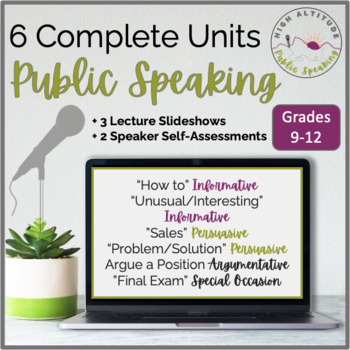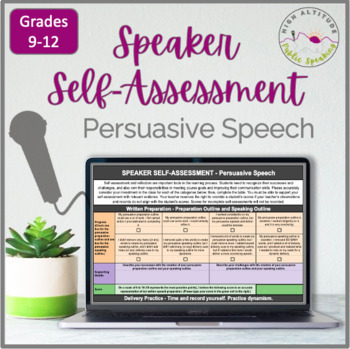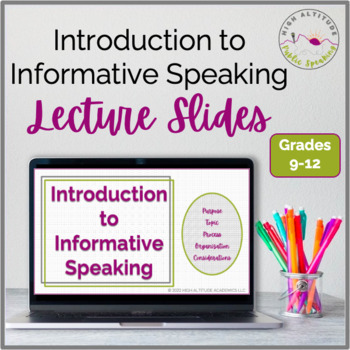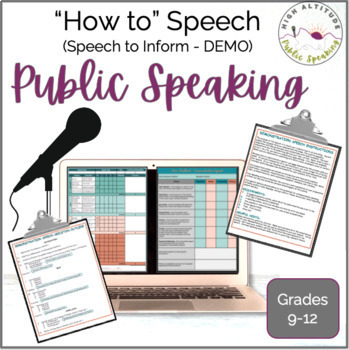PUBLIC SPEAKING Speeches (6) + Lecture Slideshows & Student Self-Assessments
- Google Drive™ folder

What educators are saying
Products in this Bundle (11)
showing 1-5 of 11 products
Description
Looking for a variety of speech presentations that are engaging and easy to implement? These activities for public speaking help students develop a critical level of presentation confidence.
These comprehensive units provide secondary ELA/English and public speaking instructors with all of the tools they need to successfully teach six different public speeches. From the auto-calculating teacher evaluation rubrics and guided speech outline templates to the post delivery self-assessment, these units are designed to make teaching easier and learning more fun.
What's Included:
- Informative "How to" Speech Unit
- Informative Speech Unit
- Persuasive "Sales" Speech Unit
- Informative Christmas (Winter Holiday) Speech Unit
- Informative Thanksgiving (Gratitude) Speech Unit
- Special Occasion Speech (Final Exam)
- Lecture Slides for Speech to Inform
- Lecture Slides for Speech to Persuade
- Lecture Slides for Slideshow Design
- Post Delivery Speaker Self-Assessment for Informative Speaking
- Post Delivery Speaker Self-Assessment for Persuasive Speaking
Materials may be printed, added directly to Google Classroom, or saved as Microsoft PPT, Word, and Excel files.
Basic Steps:
- Deliver the relevant speech lecture.
- Review the speech topic guidelines and assignment instructions.
- Students gather information and create their preparation outlines.
- Students practice with their preparation outlines and then create their speaking outlines by removing all unnecessary words and adding delivery cues.
- Students practice with their speaking outlines.
- Students deliver speeches while teachers evaluate their presentations and peers provide feedback.
- Students complete the self-assessment.
ASSIGNMENT/OUTLINES: Guide your students through the preparation process for each speech with the customizable instruction sheets. The skeleton outlines (with tips) will help students draft cohesive, developed presentations.
TEACHER EVALUATION: Speech teachers know that fair speaker evaluations require focus and efficiency. It's not easy! With this efficient Google Sheet, teachers can provide meaningful and timely feedback for student speakers. This process is so streamlined that teachers can easily score key elements of content and delivery, add guidance for growth, note areas of strength, and "Return" the evaluation to the speaker through Google Classroom---all within seconds of the speech conclusion. Include a numerical rating for each category/skill, add succinct comments, and click "Return." When the speaker is finished, the teacher is finished! The cell formulas do the calculating. Use the completed Google Sheet to easily conference with students regarding their speaking experience.
PEER FEEDBACK: This important peer feedback process for the informative speech provides public speaking students with an excellent way to learn from each other and support their peers. Providing feedback to a public speaker is a weighty responsibility.
- It requires focus.
- It requires maturity.
- It requires tact.
As students work through the peer feedback process, they'll help their classmates hone their public speaking skills while they learn more about effective speech delivery.
Speech students have as much to learn from each other as they do from their teachers. Students who complete the peer feedback process will become skilled speakers more quickly because they're not just observing a speech; they're evaluating the information, the organization, and the delivery.
Because I know that peer feedback can be difficult to manage, I've written instructions that address the peer feedback process, including considerations about motivation, careful phrasing and the goal of peer evaluation.
SLIDESHOWS: This slideshow lecture makes it easy for educators to provide background for informative presentations, persuasive presentations, and slideshow design. Slides are grouped by five main ideas:
- Purpose
- Topic
- Process
- Organization
- Considerations
POST DELIVERY SPEAKER SELF-ASSESSMENT: Simply "assign" the Google Sheet through Google Classroom. Remember to select "Make a copy for each student" when you create the assignment. The Google Sheet includes the following sections:
- Written Preparation
- Delivery Practice
- Speaking Experience
- Habits of Work
- Planning.
CHECK OUT THIS "PERFECT PAIRING":
Public Speaking Course Orientation and Course Reflection
LIKE MY CREATIONS?
I'd love to have you follow me!
INTERESTED IN MORE TEACHING RESOURCES?
Shop my store: High Altitude Academics. Thank you so much!





